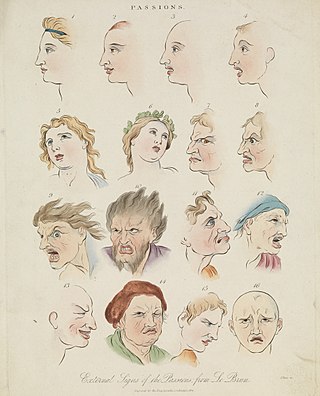Social psychology is the scientific study of how thoughts, feelings, and behaviors are influenced by the actual, imagined, or implied presence of others. Social psychologists typically explain human behavior as a result of the relationship between mental states and social situations, studying the social conditions under which thoughts, feelings, and behaviors occur, and how these variables influence social interactions.

Abraham Harold Maslow was an American psychologist who created Maslow's hierarchy of needs, a theory of psychological health predicated on fulfilling innate human needs in priority, culminating in self-actualization. Maslow was a psychology professor at Brandeis University, Brooklyn College, New School for Social Research, and Columbia University. He stressed the importance of focusing on the positive qualities in people, as opposed to treating them as a "bag of symptoms". A Review of General Psychology survey, published in 2002, ranked Maslow as the tenth most cited psychologist of the 20th century.

A personality test is a method of assessing human personality constructs. Most personality assessment instruments are in fact introspective self-report questionnaire measures or reports from life records (L-data) such as rating scales. Attempts to construct actual performance tests of personality have been very limited even though Raymond Cattell with his colleague Frank Warburton compiled a list of over 2000 separate objective tests that could be used in constructing objective personality tests. One exception however, was the Objective-Analytic Test Battery, a performance test designed to quantitatively measure 10 factor-analytically discerned personality trait dimensions. A major problem with both L-data and Q-data methods is that because of item transparency, rating scales and self-report questionnaires are highly susceptible to motivational and response distortion ranging all the way from lack of adequate self-insight to downright dissimulation depending on the reason/motivation for the assessment being undertaken.
Moral psychology is a field of study in both philosophy and psychology. Historically, the term "moral psychology" was used relatively narrowly to refer to the study of moral development. Moral psychology eventually came to refer more broadly to various topics at the intersection of ethics, psychology, and philosophy of mind. Some of the main topics of the field are moral judgment, moral reasoning, moral sensitivity, moral responsibility, moral motivation, moral identity, moral action, moral development, moral diversity, moral character, altruism, psychological egoism, moral luck, moral forecasting, moral emotion, affective forecasting, and moral disagreement.

The Big Five personality traits, sometimes known as "the five-factor model of personality" or "OCEAN model", is a grouping of five unique characteristics used to study personality. It has been developed from the 1980s onward in psychological trait theory.
Cultural psychology is the study of how cultures reflect and shape their members' psychological processes.
In social science research, social-desirability bias is a type of response bias that is the tendency of survey respondents to answer questions in a manner that will be viewed favorably by others. It can take the form of over-reporting "good behavior" or under-reporting "bad", or undesirable behavior. The tendency poses a serious problem with conducting research with self-reports. This bias interferes with the interpretation of average tendencies as well as individual differences.
A value is a universal value if it has the same value or worth for all, or almost all, people. Spheres of human value encompass morality, aesthetic preference, traits, human endeavour, and social order. Whether universal values exist is an unproven conjecture of moral philosophy and cultural anthropology, though it is clear that certain values are found across a great diversity of human cultures, such as primary attributes of physical attractiveness whereas other attributes are subject to aesthetic relativism as governed by cultural norms. This objection is not limited to aesthetics. Relativism concerning morals is known as moral relativism, a philosophical stance opposed to the existence of universal moral values.
In ethics and social sciences, value denotes the degree of importance of some thing or action, with the aim of determining which actions are best to do or what way is best to live, or to describe the significance of different actions. Value systems are prospective and prescriptive beliefs; they affect the ethical behavior of a person or are the basis of their intentional activities. Often primary values are strong and secondary values are suitable for changes. What makes an action valuable may in turn depend on the ethical values of the objects it increases, decreases, or alters. An object with "ethic value" may be termed an "ethic or philosophic good".

Shalom H. Schwartz is a social psychologist, cross-cultural researcher and creator of the Theory of Basic Human Values. He also contributed to the formulation of the values scale in the context of social learning theory and social cognitive theory.
Cross-cultural psychology is the scientific study of human behavior and mental processes, including both their variability and invariance, under diverse cultural conditions. Through expanding research methodologies to recognize cultural variance in behavior, language, and meaning it seeks to extend and develop psychology. Since psychology as an academic discipline was developed largely in North America and Europe, some psychologists became concerned that constructs and phenomena accepted as universal were not as invariant as previously assumed, especially since many attempts to replicate notable experiments in other cultures had varying success. Since there are questions as to whether theories dealing with central themes, such as affect, cognition, conceptions of the self, and issues such as psychopathology, anxiety, and depression, may lack external validity when "exported" to other cultural contexts, cross-cultural psychology re-examines them using methodologies designed to factor in cultural differences so as to account for cultural variance. Some critics have pointed to methodological flaws in cross-cultural psychological research, and claim that serious shortcomings in the theoretical and methodological bases used impede, rather than help the scientific search for universal principles in psychology. Cross-cultural psychologists are turning more to the study of how differences (variance) occur, rather than searching for universals in the style of physics or chemistry.
According to some theories, emotions are universal phenomena, albeit affected by culture. Emotions are "internal phenomena that can, but do not always, make themselves observable through expression and behavior". While some emotions are universal and are experienced in similar ways as a reaction to similar events across all cultures, other emotions show considerable cultural differences in their antecedent events, the way they are experienced, the reactions they provoke and the way they are perceived by the surrounding society. According to other theories, termed social constructionist, emotions are more deeply culturally influenced. The components of emotions are universal, but the patterns are social constructions. Some also theorize that culture is affected by the emotions of the people.
Hazel June Linda Rose Markus is an American social psychologist and a pioneer in the field of cultural psychology. She is the Davis-Brack Professor in the Behavioral Sciences at Stanford University in Stanford, California. She is also a founder and faculty director of Stanford SPARQ, a "do tank" that partners with industry leaders to tackle disparities and inspire culture change using insights from behavioral science. She is a founder and former director of the Research Institute of the Center for Comparative Studies in Race and Ethnicity (CCSRE). Her research focuses on how culture shapes mind and behavior. She examines how many forms of culture influence the self, and in turn, how we think, feel, and act.

Emotion classification, the means by which one may distinguish or contrast one emotion from another, is a contested issue in emotion research and in affective science. Researchers have approached the classification of emotions from one of two fundamental viewpoints:
- that emotions are discrete and fundamentally different constructs
- that emotions can be characterized on a dimensional basis in groupings
Conformity is the act of matching attitudes, beliefs, and behaviors to group norms, politics or being like-minded. Norms are implicit, specific rules, guidance shared by a group of individuals, that guide their interactions with others. People often choose to conform to society rather than to pursue personal desires – because it is often easier to follow the path others have made already, rather than forging a new one. Thus, conformity is sometimes a product of group communication. This tendency to conform occurs in small groups and/or in society as a whole and may result from subtle unconscious influences, or from direct and overt social pressure. Conformity can occur in the presence of others, or when an individual is alone. For example, people tend to follow social norms when eating or when watching television, even if alone.
The VIA Inventory of Strengths (VIA-IS), formerly known as the "Values in Action Inventory," is a proprietary psychological assessment measure designed to identify an individual's profile of "character strengths".
Values scales are psychological inventories used to determine the values that people endorse in their lives. They facilitate the understanding of both work and general values that individuals uphold. In addition, they assess the importance of each value in people's lives and how the individual strives toward fulfillment through work and other life roles, such as parenting. Most scales have been normalized and can therefore be used cross-culturally for vocational, marketing, and counseling purposes, yielding unbiased results. Psychologists, political scientists, economists, and others interested in defining values, use values scales to determine what people value, and to evaluate the ultimate function or purpose of values.
In personality psychology, the lexical hypothesis generally includes two postulates:
Moral foundations theory is a social psychological theory intended to explain the origins of and variation in human moral reasoning on the basis of innate, modular foundations. It was first proposed by the psychologists Jonathan Haidt, Craig Joseph, and Jesse Graham, building on the work of cultural anthropologist Richard Shweder. More recently, Mohammad Atari, Jesse Graham, and Jonathan Haidt have revised some aspects of the theory and developed new measurement tools. The theory has been developed by a diverse group of collaborators and popularized in Haidt's book The Righteous Mind. The theory proposes that morality is "more than one thing", first arguing for five foundations, and later expanding for six foundations :
Cultural differences can interact with positive psychology to create great variation, potentially impacting positive psychology interventions. Culture differences have an impact on the interventions of positive psychology. Culture influences how people seek psychological help, their definitions of social structure, and coping strategies.





